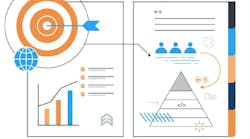No More Third-Party Cookies? 4 Strategies to Keep Your Marketing from Crumbling
Marketers rely on data to analyze consumer behavior, measure campaign performance and maximize opportunities to engage through data-driven advertising and digital marketing strategies. As data collection practices and privacy continue to make headlines, customers are increasingly becoming more vocal about their discomfort with this marketing status quo.
In fact, a 2019 Pew Research study found that 81% of people feel like they have no control over how businesses collect their data, and 79% are concerned about how companies use it.
These data privacy concerns have led to larger data privacy laws and regulations (like GDPR) requiring brands to follow stringent collection requirements, such as receiving explicit consent to save individual data and activity. Technologies like ad blockers, incognito browsers, or no-tracking search engines like DuckDuckGo have grown in popularity to help customers maintain data privacy.
Which is why Google—one of the main players behind this ubiquitous online tracking—is starting to put limits on it.
Google’s Update
Cookies—the small files websites use to track and record information about visitors and the actions they take on a site—attach web activity to the single individual, and then Google sells web advertisements to target an individual user based on their browsing habits.
Starting in early 2020, Google announced a plan to phase out all use of third-party cookies in its ad network and Chrome. They reiterated their intention to continue on this path with a recent announcement that they won’t be replacing third-party cookies with any similar tracking technology.
It’s important to note that Google can continue to track and target ads based on first-party data (data you input into their products, like Search or YouTube), and these data sources will not be impacted. Google removing third-party ads isn’t going to slow down Google, but it adds challenges for advertisers and marketers. Brands relying on this technology to gain more detailed analytics and develop marketing campaigns that incorporate personalization are now having to rethink their overall strategy.
Adapting to a World without Cookies
Smart marketers don’t need third-party cookies for effective marketing. Here are four strategies to help you adapt.
1. Give customers value, get consent
The end of third-party cookies doesn’t mean businesses have to stop collecting and using data in marketing initiatives; you just have to maximize the data people hand over willingly. Namely, first-person data or data that is provided to you by a customer on a digital property you own, like your website.
Some businesses encourage account creation to get access to use a software or see wholesale pricing. They may let customers create wish lists or mark “liked” items—a valuable feature to motivate a customer to create an account. Similarly, you can offer a content download or a product demo in return for an email address and encourage subscribers to complete a survey or a preference center to gain additional data.
Give customers valuable offers or content to incentivize them to willingly part with their data. Once you have explicit opt-in, you can personalize your approach or offers based on what you know a visitor likes or their order history.
2. Explore email segmentation and preference centers
Maximizing your email list is just one way to best leverage first-party data. According to the 2021 Digital Consumer Trends Report, email is the most effective medium for driving sales, beating other channels by up to 92%. Luckily for brands, email is one of the easiest channels for providing a personalized experience.
Instead of creating one email list and sending the same content to all subscribers, use first-party data available, like order history or preference center data, to segment your list and tailor emails to customers’ interests.
Even better, many subscribers will provide more data in exchange for a reward. For example, brands can send birthday offers each year in exchange for capturing a customer’s birth date.
3. Tailor your content
Contextual personalization—tailoring your ads and content based on what’s on a webpage or targeted search keywords—remains an option in a cookie-less world.
Contextual advertising is targeting users based on a theme or topic of the webpage. Displaying ads for a kitchen mixer on recipe blogs, for instance, or beer ads on a brewer’s website.
Based on the content the audience is looking for, you use keywords to match your ad to that content. Banner ads can show up on pages where the content includes related keywords, or websites that cover relevant topics. (This is more general, and therefore different, than the cookie-based approach of targeting the ad to the individual’s browsing history.)
On your own website, contextual personalization could take the form of product recommendations. When someone views the product page for a couch, recommendation software can automatically suggest the matching loveseat.
4. Focus on customer loyalty
When it comes to long-term success, it pays most to invest in the customers that buy from you again and again vs. those that visit your website once or twice. The Digital Consumer Trends Report found that 79% of consumers would rather brands invest in loyalty programs than social advertising.
Building trust through loyalty is mutually beneficial. To join your loyalty program, consumers provide information about themselves and what products they’re interested in, in exchange for perks like discounts, special offers, free shipping, and early access. In fact, a new McKinsey survey shows that consumers in paid loyalty programs are 62% more likely to spend more with a brand and 59% more likely to choose the brand over competitors
Don’t stop there—build a loyalty business, not just a loyalty program. Continuously look at your product and service offering, and marketing or sales approach, to identify ways to create more meaningful and genuine interactions with your customers.
Invest in earning loyalty, and you’ll gain customers’ trust. In turn, customers will be more willing to provide you necessary first-person data to power more effective experiences.
The people have spoken, and they feel uncomfortable with brands tracking their actions around the web without consent. They prefer personalized experiences that come from information willingly provided.
That may require a shift in your current digital marketing strategy, but it’s not a step down. You’ll earn more trust and loyalty by focusing on building a customer-first foundation for marketing and sales success (regardless of the whims of tech giants).
Randi Mohr, vice president of customer success and marketing for digital agency Whereoware, ensures clients’ digital services achieve intended business objectives. Mohr also oversees Whereoware’s brand messaging and marketing efforts to accelerate sales growth.




